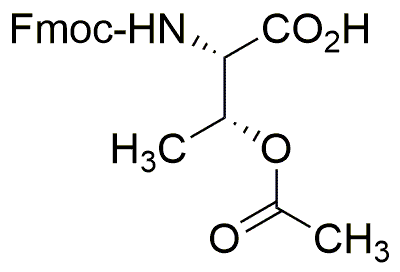Fmoc-O-acetyl-L-threonine is widely utilized in research focused on:
- Peptide Synthesis: This compound serves as a key building block in the synthesis of peptides, particularly in solid-phase peptide synthesis (SPPS), allowing for the efficient assembly of complex peptide structures.
- Drug Development: It plays a significant role in the pharmaceutical industry, where it is used to develop peptide-based drugs, enhancing the efficacy and specificity of therapeutic agents.
- Bioconjugation: The chemical is employed in bioconjugation processes, facilitating the attachment of peptides to other biomolecules, which is crucial for the development of targeted drug delivery systems.
- Research in Protein Engineering: Researchers utilize this compound to modify proteins, enabling the study of protein interactions and functions, which is vital for understanding biological processes.
- Analytical Chemistry: It is used in analytical methods to characterize peptide structures, helping scientists to confirm the identity and purity of synthesized compounds.
General Information
Properties
Safety and Regulations
Applications
Fmoc-O-acetyl-L-threonine is widely utilized in research focused on:
- Peptide Synthesis: This compound serves as a key building block in the synthesis of peptides, particularly in solid-phase peptide synthesis (SPPS), allowing for the efficient assembly of complex peptide structures.
- Drug Development: It plays a significant role in the pharmaceutical industry, where it is used to develop peptide-based drugs, enhancing the efficacy and specificity of therapeutic agents.
- Bioconjugation: The chemical is employed in bioconjugation processes, facilitating the attachment of peptides to other biomolecules, which is crucial for the development of targeted drug delivery systems.
- Research in Protein Engineering: Researchers utilize this compound to modify proteins, enabling the study of protein interactions and functions, which is vital for understanding biological processes.
- Analytical Chemistry: It is used in analytical methods to characterize peptide structures, helping scientists to confirm the identity and purity of synthesized compounds.
Documents
Safety Data Sheets (SDS)
The SDS provides comprehensive safety information on handling, storage, and disposal of the product.
Product Specification (PS)
The PS provides a comprehensive breakdown of the product’s properties, including chemical composition, physical state, purity, and storage requirements. It also details acceptable quality ranges and the product's intended applications.
Certificates of Analysis (COA)
Search for Certificates of Analysis (COA) by entering the products Lot Number. Lot and Batch Numbers can be found on a product’s label following the words ‘Lot’ or ‘Batch’.
Numéro de catalogue
Numéro de lot/série
Certificates Of Origin (COO)
This COO confirms the country where the product was manufactured, and also details the materials and components used in it and whether it is derived from natural, synthetic, or other specific sources. This certificate may be required for customs, trade, and regulatory compliance.
Numéro de catalogue
Numéro de lot/série
Safety Data Sheets (SDS)
The SDS provides comprehensive safety information on handling, storage, and disposal of the product.
DownloadProduct Specification (PS)
The PS provides a comprehensive breakdown of the product’s properties, including chemical composition, physical state, purity, and storage requirements. It also details acceptable quality ranges and the product's intended applications.
DownloadCertificates of Analysis (COA)
Search for Certificates of Analysis (COA) by entering the products Lot Number. Lot and Batch Numbers can be found on a product’s label following the words ‘Lot’ or ‘Batch’.
Numéro de catalogue
Numéro de lot/série
Certificates Of Origin (COO)
This COO confirms the country where the product was manufactured, and also details the materials and components used in it and whether it is derived from natural, synthetic, or other specific sources. This certificate may be required for customs, trade, and regulatory compliance.


